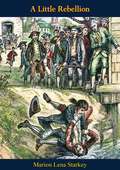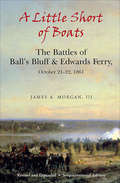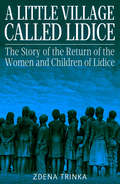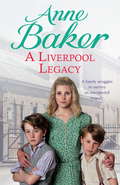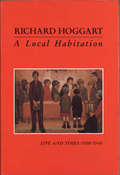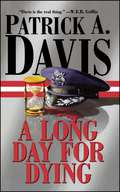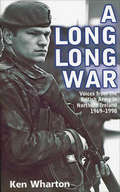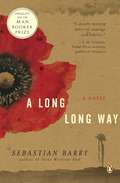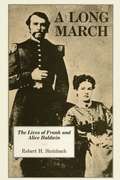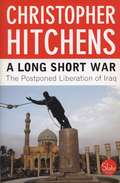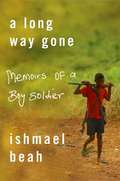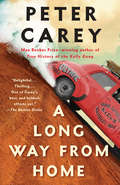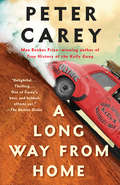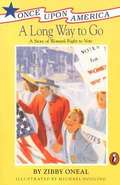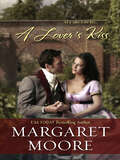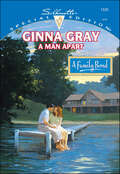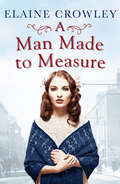- Table View
- List View
A Little Rebellion
by Marion Lena StarkeyMiss Starkey, author of the famed Death in Massachusetts, with her customary magic touch here deals with the tragic interplay of arrogance in high places and ignorance in low.TIME: the wake of the American RevolutionPLACE: western MassachusettsSUBJECT: the series of revolts culminating in Shays’ RebellionPROVOCATION: plain human misery and the heartbreak and disillusionment that await the victors of warsThe Yankee farmer, having thrown off the tyranny of the British King, dreamed of a Utopia in which taxes would be trifling and debts remitted. Instead they faced the harsh edicts of the Boston aristocrats. Was this not enough to anger a man?So the embattled farmers of ‘76 once more picked up their muskets and took to the road, animated by the same spirit that had moved them 10 years before. They were supported by much of the old revolutionary paraphernalia: county conventions, committees of correspondence, resources solemnly taken.It wasn’t a long war. But it had consequences. No event that called Washington back to public life and impelled thirteen state governments of violently divergent interests to form a more perfect union can be lightly dismissed.Both sides soon invented their devils, for we have always been eager to believe, especially in rural America, in some great but essentially simple conspiracy in high places. The embattled farmers thought the Boston aristocrats aimed at tyranny, and Governor Bowdoin thought that British agents were behind the rebellion. Then as now, it was a time of inflation, high taxes, loyalty oaths—and anxiety. Then as now, arrogance and ignorance did their evil work.Miss Starkey, as always, has so steeped herself in the records left by plain people that the book reads like a novel, although there is not one word of fiction in it. It is a stirring revelation, in dramatic form, of the eternal conflict between man’s political illusions and hard reality.
A Little Short of Boats: The Battles of Ball's Bluff & Edwards Ferry, October 21–22, 1861
by James A. Morgan III“Perhaps a small demonstration on your part would have the effect to move them,” wrote Maj. Gen. George B. McClellan to Brig. Gen. Charles P. Stone on October 20, 1861. The simple telegram triggered the “demonstration” by Col. Edward Baker’s brigade the following day—that evolved into the bloody subject of this book. <p><p> Opposing the Union effort was Brig. Gen. Nathan “Shanks” Evans’ small Confederate command at Leesburg. When he learned of the enemy plans, Evans shuttled troops from Edwards Ferry to Ball’s Bluff, where Baker pushed his brigade across the upper reaches of the Potomac. His troops were on open ground, ill-organized, and with their backs to the river when the Southern infantry attacked. The twelve fitful hours of fighting that followed ended in one of the worst defeats, proportionally speaking, that either side would suffer during the Civil War, wrecked a Union general’s career, and killed Baker—a sitting US senator and one of Abraham Lincoln’s good friends. The news rocked a Northern populace already reeling from the recent disasters of Bull Run and Wilson’s Creek. <p> Based on firsthand research and a full appreciation of the battlefield terrain, A Little Short of Boats sets forth the strategy behind the “demonstration,” the combats that followed, and the colorful personalities involved. The result, coupled with the disaster’s political fallout, held the nation’s attention for weeks. The battle’s most important impact was also the least predictable: the creation of the Joint Committee on the Conduct of the War. Ostensibly formed to seek out the causes of the string of defeats, the Joint Committee instead pushed the political agenda of the “Radical Republicans” and remained a thorn in Lincoln’s side for four long years. <p> This fully revised and expanded edition of A Little Short of Boats will please Civil War enthusiasts who love tactical studies—and remind them once again that very often in history, smaller affairs often have important and lasting consequences.
A Little Village Called Lidice
by Zdena TrinkaA Little Village Called Lidice, first published in 1947, is an impassioned account of the World War II atrocity committed by the Nazis in Lidice, Czechoslovakia. The reprisal was ordered by Hitler following the assassination of Nazi leader Reinhard Heydrich on May 27, 1942 outside of Prague. On June 9, 1942, Gestapo and other German forces entered the small village of Lidice (chosen apparently at random by the Nazis), rounded up all men and male teenagers 15 and over, and executed them by firing squad (173 in all). Their bodies were placed in a common grave. Some women were also executed, with most transported to concentration camps. A handful of the approximately 100 village children were removed from their mothers to be raised by German families, but over 80 were sent to their death in the extermination camp at Chelmo, where they were placed in sealed trucks and gassed. Following the executions, the village was razed by fire, leveled by explosives, then bulldozed into rubble. The village's famous cherry orchards were also uprooted and destroyed, a small lake was filled-in, and a stream diverted. Grass was planted so that the village was, in effect, obliterated. At war's end, only a few women and 17 Lidice children survived to return to the village. Following the war, houses for a new Lidice were built near the site of the original village, and a memorial erected in honor of those who were killed.Author Zdena Trinka (1892-1967) was a native of North Dakota who wrote a number of additional books, mostly concerning the history of North Dakota. She escaped the Nazi invasion of Czechoslovakia while on a visit.
A Little in Love: 'The perfect romantic read' HEIDI SWAIN, Sunday Times Bestselling author
by Florence Keeling&‘Tender and engrossing, this romance will touch your heart and make you smile' RACHEL HORE 'The perfect romantic read' HEIDI SWAIN 'You&’ll fall a lot in love with A Little in Love. Secrets, romance, escapism - yes please!' JULIET ASHTON'A warm, delightful joy of a book' PATRICIA SCANLAN 'An absolutely charming and joyful read with lots of laugh-out-loud moments along the way. Overflowing with fabulous friendships, dreamy romance and all things weddings, it really did warm my heart and leave me with a big smile on my face' KIM NASH &‘Fun, fresh and full of fizz, I loved it!&’ LAURA KEMP 'I fell more than a little in love with this book. Florence is an incredible storyteller and this book is the perfect cute romance read' LUCY KEELING 'A warm, comfort read of a book with the kind of rom-com characters you recognise and root for' ANNA MANSELL &‘I thoroughly enjoyed this heart-warming and ever-so-cute story. What an adorable tale!&’ LUCY MITCHELL &‘I absolutely loved this charming romance! It was funny, fresh and an utterly fabulous read&’ HOLLY MARTIN 'A good old fashioned 'will they, won't they' romance filled with as much fun and sparkle as the bubbles in Rose's prosecco. Perfect escapism, best enjoyed with a glass of fizz!' KATHLEEN WHYMANThe little village of Weddington is fast becoming THE place to get married. With its stately home, castle and two churches it has something for everyone, and now, famous after appearing in huge romcom movie hit A Little In Love, it&’s hosting a monthly wedding fayre… Rose Pedal is the proud owner of Pedals & Prosecco, a brand new business serving ice-cold fizz from a vintage bicycle, and she&’s excited to be attending her first wedding fayre. But, on the way to Weddington Hall she&’s involved in a near miss crash involving dashingly handsome James from Blume&’s Florist. Arriving at the beautiful stately home drenched and disheveled, Rose is horrified to find James is not only not sorry for nearly knocking her off her bike, but he&’s gatecrashing her allocated spot on the lawn. His arrogance gets her back up and it&’s definitely a case of hate at first sight. But as the wedding fayre season continues, James gently wins Rose over, and their relationship starts to bloom. Can being just 'a little in love' help Rose and James find their own happy-ending…A Little in Love is the most charming romantic comedy you&’ll read this year, from a hugely talented author, perfect for fans of Cathy Bramley, Phillipa Ashley and Cressida McLaughlin.
A Liverpool Legacy: An unexpected tragedy forces a family to fight for survival…
by Anne BakerA mother's love is a force to be reckoned with... Set in Liverpool at the end of the Second World War, Anne Baker's saga, A Liverpool Legacy, will move you to tears of sadness and joy. Perfect for fans of Lyn Andrews and Dilly Court.On a spring day in 1947, Millie and Pete Maynard take their daughter Sylvie on a boat trip that is to end in tragedy. Poor Sylvie blames herself for the accident and Millie needs all her strength to comfort her children and overcome her grief. Then Pete's will is read and further heartache lies in store...Meanwhile, Pete's younger brother and his good-for-nothing sons try to take control of the family business, but they've underestimated Millie's indomitable spirit. She's worked in Maynard's perfume laboratory for eighteen years and is determined to protect her husband's legacy no matter what obstacles are thrown in her way... What readers are saying about A Liverpool Legacy: 'Anne Baker is one of my favourite authors and I have read all her books. A Liverpool Legacy is up there amongst her best - a really well written, gripping story, with believable characters''Anne Baker never ceases to amaze me, another brilliant read'
A Local Habitation: Life and Times, Volume One 1918-40
by Richard HoggartRichard Hoggart's book, The Uses of Literary, established his reputation as a uniquely sensitive and observant chronicler of English working-class life. In this vivid first volume of autobiography he describes his origins in that milieu. Orphaned at an early age, Hoggart grew up in a working-class district of Leeds, in an intimate world of terraced back-to-backs, visits from the local Board of Guardians, clothing checks and potted-meat sandwiches. With affectionate insight he recreates the family circle - a loving grandmother, one domineering and on gentle aunt, and a bibulous, melancholy uncle - and recalls his early schooling, the friends he made and the mentors he admired. Hard-working and articulate, Hoggart did well enough at grammar school to go on to Leeds University. This volume ends as, having earned a higher degree and travelled in Nazi Germany, he prepares to leave Yorkshire, via the Army, for the world beyond. Wry, compassionate, exact, A Local Habitation is a classic recreation of working-class England between the wars.
A Log of the Vincennes
by Lt. Donald Hugh DorrisAN INTERESTING AND INSTRUCTIVE CONTRIBUTION TO THE HISTORY OF WORLD WAR IIThe LOG begins with U.S. Sloop Vincennes, which, with the Columbus, was the first American ship to enter Tokyo Harbor (1846).A contemporaneous account of the shakedown cruise of the U.S. Cruiser Vincennes in 1937 and experiences of the ship before escorting the Hornet on the Doolittle-Tokyo expedition are given.The contents also include likenesses and biographical sketches of many men lost with the Vincennes; the Chaplain’s Log; experiences at Midway; and a statement concerning the third U.S. Vincennes, launched in 1944.Richly illustrated throughout with photographs and maps.
A Lonely Kind of War
by Marshall HarrisonTells the story of the FACs (forward air controllers) who flew light, unarmored and often unarmed aircraft over the jungles of Vietnam. Their job was to find enemy troop and supply concentrations and direct fighters, artillery, gunships and bombers to them.
A Long Day for Dying
by Patrick A. DavisNew York Times bestselling author Patrick A. Davis spins a gripping tale of deadly intrigue in a time of national crisis that races to the explosive final act. A LONG DAY FOR DYING When General Michael Garber, the newly appointed Chairman of the Joint Chiefs of Staff, is discovered dead in the private compartment of his airplane, Air Force investigator Martin Collins finds himself thrust into the most dangerous case of his career. What initially appears to be an accidental death turns out to be a near-perfect murder -- and three members of the Joint Chiefs are the prime suspects. As Martin weaves his way through a puzzling maze of blood and deceit, he finds himself in the firing line of Garber's enemies, including a half-mad rival general who collects the ears of the men he's killed, and the ruthless female secretary of defense, whose hatred for Garber knows no bounds. With his life and the honor of the military at stake, Martin has only twenty-four hours to uncover a legacy of secrets that no one wants brought to light -- secrets that the most powerful forces in Washington will kill to keep buried....
A Long Long War: Voices from the British Army in Northern Ireland 1969–98
by Ken WhartonThis is the story of the Troubles in Northern Ireland told from the perspective of the British soldiers who served there between 1969 and 1998. This was a war against terrorists who knew no mercy or compassion; a war involving sectarian hatred and violent death. Over 1,000 British lives were lost in a place just 30 minutes flying time away from the mainland. The British Army was sent into Northern Ireland on August 14, 1969 by the Wilson government as law and order had broken down and the population (mainly Catholics) and property were at grave risk. Between then and 1998 some 300,000 British troops served in Northern Ireland. This is their story—in their own words—from first to last. There are stories from some of the most seminal moments in the period of the Troubles in Northern Ireland—detailed accounts of firefights at Crossmaglen from the commanders on the ground at the time; an incredible story from a British Army sniper in Londonderry, 1973; an account from the first squaddie on the scene at Penny Lane after the 1988 funeral killings of the two corporals; the 1988 Ballygawley coach blast which killed 8 Light Infantrymen, with a first-hand account by one of the survivors; the case of the missing Christmas Club money in the Ardoyne; Gerry Adams' 'birthday treat' at a vehicle checkpoint, accounts by plain-clothes intelligence officers on the streets of Belfast and many more. The brave men and women of the Ulster Defence Regiment, many of whom were murdered in their homes or at their places of work, occupy a prominent place in the book. The author has also conducted a great deal of original research to produce a roll of honor for all service personnel killed in Northern Ireland. A major contribution to research, the list differs to its 'official' MoD counterpart to a surprising degree. It includes more than 20 names before the first official casualty, Gunner Robert Curtis (1971) and more than 10 after the last official casualty, L/Bombardier Stephen Restorick (1997). Receiving a remarkable amount of cooperation from Northern Ireland veterans eager to tell their story, the author has compiled a vivid and unforgettable record. Their experiences—sad and poignant, fearful and violent, courageous in the face of adversity, even downright hilarious—make for compelling reading. Their voices need to be heard.
A Long Long Way
by Sebastian BarryPraised as a "master storyteller" (The Wall Street Journal) and hailed for his "flawless use of language" (Boston Herald), Irish author and playwright Sebastian Barry has created a powerful new novel about divided loyalties and the realities of war.In 1914, Willie Dunne, barely eighteen years old, leaves behind Dublin, his family, and the girl he plans to marry in order to enlist in the Allied forces and face the Germans on the Western Front. Once there, he encounters a horror of violence and gore he could not have imagined and sustains his spirit with only the words on the pages from home and the camaraderie of the mud-covered Irish boys who fight and die by his side. Dimly aware of the political tensions that have grown in Ireland in his absence, Willie returns on leave to find a world split and ravaged by forces closer to home. Despite the comfort he finds with his family, he knows he must rejoin his regiment and fight until the end. With grace and power, Sebastian Barry vividly renders Willie's personal struggle as well as the overwhelming consequences of war.
A Long March: The Lives of Frank and Alice Baldwin
by Robert H. SteinbachDuring a distinguished military career, in which he rose to the rank of brigadier general and twice won the Medal of Honor, Frank Baldwin saw service in the Civil War, the Indian wars on the Great Plains, and the Spanish-American War. His wife, Alice Blackwood Baldwin, shared the "long march" with him, from his Plains service onward. In this first biography of the Baldwins, Robert Steinbach combines military and personal history to vividly portray a marriage that survived both the harshness of frontier army life and the restrictive Victorian concept of "separate spheres" for husband and wife. Drawing on a wealth of diaries, letters, and other family papers, Steinbach re-creates the Baldwins' life on the Plains. Moving from post to post in Kansas, New Mexico, Montana, North Dakota, and Texas, they faced danger, excitement, separations, poverty, and many other hardships. Frequently they clashed over Alice's desire to be something more than "an ornament to society"-a wish eventually granted as Frank's long absences and chronic ill health required Allie to take responsibility for herself and their daughter. With insights into military campaigns on the Great Plains in the years 1865-1890 and a revealing look at the human side of those campaigns, A Long March will appeal to a wide audience.
A Long Short War: The Postponed Liberation of Iraq
by Christopher HitchensSelected essays from his work on the subject.
A Long Way Gone: Memoirs of a Boy Soldier
by Ishmael Beah<P>My new friends have begun to suspect I haven't told them the full story of my life. <br>"Why did you leave Sierra Leone?" <br>"Because there is a war." <br>"You mean, you saw people running around with guns and shooting each other?" <br>"Yes, all the time." <br>"Cool." <P>I smile a little. <br>"You should tell us about it sometime." <br>"Yes, sometime." ... <P>This absorbing account by a young man who, as a boy of 12, gets swept up in Sierra Leone's civil war goes beyond even the best journalistic efforts in revealing the life and mind of a child abducted into the horrors of warfare. Beah's harrowing journey transforms him overnight from a child enthralled by American hip-hop music and dance to an internal refugee bereft of family, wandering from village to village in a country grown deeply divided by the indiscriminate atrocities of unruly, sociopathic rebel and army forces. <P>Beah then finds himself in the army-in a drug-filled life of casual mass slaughter that lasts until he is 15, when he's brought to a rehabilitation center sponsored by UNICEF and partnering NGOs. The process marks out Beah as a gifted spokesman for the center's work after his "repatriation" to civilian life in the capital, where he lives with his family and a distant uncle. When the war finally engulfs the capital, it sends 17-year-old Beah fleeing again, this time to the U.S., where he now lives. (Beah graduated from Oberlin College in 2004.) <P>Told in clear, accessible language by a young writer with a gifted literary voice, this memoir seems destined to become a classic firsthand account of war and the ongoing plight of child soldiers in conflicts worldwide.
A Long Way from Home: A Novel
by Peter CareyOver the course of his stellar writing life, Peter Carey has explored his homeland of Australia in such highly acclaimed novels as Oscar and Lucinda, True History of the Kelly Gang and Amnesia. Writing at the peak of his powers, Carey takes us on an unforgettable journey that maps his homeland's secrets in this extraordinary new novel. <P><P>Wildly inventive, funny and profoundly moving, A Long Way from Home opens in 1953 with the arrival of the tiny, handsome Titch Bobs, his beautiful doll of a wife, Irene, and their two children in the small town of Bacchus Marsh. Titch is the best car salesman in southeastern Australia. Irene loves her husband, and loves to drive fast. <P>Together they enter the Redex Trial, a brutal endurance race around the ancient continent, over roads no car is designed to survive. With them is their neighbour and navigator, Willie Bachhuber, a quiz show champion and failed school teacher who calls the turns and creek crossings on a map that will lead them, without warning, away from the white Australia they all know so well. <P>Just like the novel, Peter Carey's new masterpiece, begins in one way and takes you somewhere you never thought you'd be. Often funny, the book is also and always a page-turner, surprising you with history these characters never even knew themselves. Its profound reckoning with Australia's brutal treatment of the continent's aboriginal people will also resonate strongly with Canadian readers.
A Long Way from Home: A novel
by Peter CareyThe two-time Booker Prize-winning author now gives us a wildly exuberant, wily new novel that circumnavigates 1954 Australia, revealing as much about the country/continent as it does about three audacious individuals who take part in the infamous 10,000-mile race, the Redex Trial. <P><P>Irene Bobs loves fast driving. Her husband is the best car salesman in southeastern Australia. <P>Together they enter the Redex Trial, a brutal race around the ancient continent, over roads no car will ever quite survive. <P>With them is their lanky, fair-haired navigator, Willie Bachhuber, a quiz show champion and failed schoolteacher who calls the turns and creeks crossings on a map that will remove them, without warning, from the white Australia they all know so well. <P>This is a thrilling high-speed story that starts in one way, and then takes you someplace else. It is often funny, more so as the world gets stranger, and always a page-turner even as you learn a history these characters never knew themselves. <P>Set in the 1950s, this is a world every American will recognize: black, white, who we are, how we got here, and what we did to each other along the way. <P>A Long Way from Home is Peter Carey's late-style masterpiece.
A Long Way from Verona (Abacus Bks.)
by Jane Gardam&“Far more than just another coming-of-age story&” from the award-winning author of the Old Filth trilogy (Bustle). Jane Gardam&’s marvelous stories of young girls on the threshold of womanhood—God on the Rocks and Crusoe&’s Daughter—have delighted fans and critics alike. These &“modern classics&” are now joined by a novel that is equally fresh and genuine, comic and touching (The Independent). Jessica Vye introduces herself with an enigmatic pronouncement: &“I ought to tell you at the beginning that I am not quite normal, having had a violent experience at the age of nine.&” A revered author has told Jessica that she is, beyond all doubt, a born writer. This proves an accurate prediction of the future, one that indelibly colors her life at school and her perception of the world. Jessica has always known that her destiny would be shaped by her refusal to conform, her compulsion to tell the absolute truth, and her dedication to observing the strange wartime world that surrounds her. What she doesn&’t know, however, is that the experiences and ideas that set her apart will also lead her to a new and wholly unexpected life. Told with grace and inimitable wit, A Long Way from Verona is a wise and vivid portrait of adolescent discovery and impending adulthood. &“A book to be judged by the highest standards.&” —The Spectator &“A brilliant, witty, and agonizingly true-to-life novel.&” —The Times Literary Supplement &“A fiercely funny and personal book.&” —The Economist &“The qualities for which Gardam is cherished (the quirkiness, the bright-eyed wonder at reality) are already apparent in this early work.&” —Kirkus Reviews
A Long Way to Go: A Story of Women's Right to Vote
by Zibby OnealWho is affected by the events of history? Not only the famous and powerful. Individuals from every part of society contribute a story--and so weave together history. Some of the finest storytellers bring their talents to this series of historical fiction, based on careful research and designed specifically for readers ages 7-11. These are tales of young people growing up in a young, dynamic country. Each Once Upon America volume shapes the reader's understanding of the people who built America and of his or her own role in our unfolding history. For history is a story that we continue to write, with a chapter for each of us beginning, "Once upon America."
A Lover's Kiss
by Margaret MooreAn English ex-spy is rescued by a poor French seamstress in this suspenseful Regency romance by a USA Today–bestselling author.Sir Douglas Drury was a spy during the Napoleonic war and has the scars, and enemies, to show for it. When he is set upon in a London street, he finds it hard to be grateful because his rescuer is not only a woman, but French into the bargain!Juliette Bergerine has learned to keep herself safe by avoiding undue attention, but now her life is also in danger and, together, she and Drury must take refuge in a Mayfair mansion. There, this broodingly cynical man proves an irresistible temptation. . . .Praise for A Lover’s Kiss“Moore continues to captivate with her latest historical. . . . The conflict pulls readers in, and the villain is most definitely a surprise.” —RT Book Reviews“A Lover’s Kiss is a suspenseful, tragic romance of the first order! I recommend A Lover’s Kiss especially to readers who enjoy the Regency period knowing that there is just a smattering of intimacy and plenty of drama.” —Romance Reader at Heart, Top Pick
A Lucky Sixpence: A dramatic and heart-warming Liverpool saga
by Anne BakerA poignant and dramatic saga set in Liverpool, perfect for fans of Katie Flynn, Annie Groves and Lyn Andrews. Praise for Anne Baker's Merseyside sagas: 'A stirring tale of romance and passion, poverty and ambition' Liverpool EchoIt's 1937 and for sisters Lizzie and Milly Travis there's nothing quite like the thrill of the funfair at New Brighton. Amid the bright lights and whirling rides, Lizzie wins a lucky sixpence on a stall - as well as the heart of a handsome stallholder.Ben McCluskey isn't the type of man Lizzie's respectable parents had in mind for her, nevertheless the young couple embark on a whirlwind romance. Lizzie's mother worries that history will repeat itself when Ben introduces her daughter to a world she never knew existed. And, as war looms, Milly realises that her sister's luck can't last for ever...
A Mad Catastrophe: The Outbreak of World War I and the Collapse of the Habsburg Empire
by Geoffrey WawroA prizewinning military historian explores a critical but overlooked cause for World War I: the staggering decrepitude of the Austro-Hungarian Empire.
A Man Apart (A Family Bond)
by Ginna GrayHE WAS THE MOST MAGNIFICENT MAN SHE'D EVER ENCOUNTEREDMaude Ann knew she was in trouble when wounded detective Matthew Dolan was sent to Henley Haven to recuperate. The nurturing foster mom couldn't afford to fall for another man in blue, yet Matt's piercing eyes and gut-wrenching loneliness stirred something deep inside of her. Now it wasn't a question of if she'd surrender to their electrifying passion but when...
A Man Called Intrepid: The Incredible True Story of the Master Spy Who Helped Win World War II (Lyons Press Ser.)
by William StevensonThe classic real-life story of the superspy whose vast intelligence network helped defeat the Nazis in World War II.A Man Called Intrepid is the account of the world's first integrated intelligence operation and of its master, William Stephenson. Codenamed INTREPID by Winston Churchill, Stephenson was charged with establishing-and running-a vast, worldwide intelligence network to challenge the terrifying force of Nazi Germany. Nothing less than the fate of Britain and the free world hung in the balance as INTREPID covertly set about stalling the Nazis by any means necessary.First published in 1976, A Man Called Intrepid was an immediate bestseller. With over thirty black-and-white photographs and countless World War II secrets, this book revealed startling information that had remained buried for decades. Detailing the infamous "Camp X" training center in Ontario, Canada; the miraculous breaking of the Ultra Code used by the Enigma Machine; and dozens of other stories of clandestine missions, A Man Called Intrepid is an undisputed modern classic.
A Man From Corpus Christi: Or The Adventures Of Two Bird Hunters And A Dog In Texan Bogs (classic Reprint)
by A C PeirceIn "A Man From Corpus Christi," A. C. Peirce presents a riveting account of life on the American frontier through the eyes of a rugged and resourceful protagonist. This captivating narrative immerses readers in the wild, untamed landscapes of Texas, capturing the essence of a bygone era marked by adventure, danger, and the relentless pursuit of justice.The story follows the journey of a man from Corpus Christi, whose indomitable spirit and unwavering determination set him apart in a land where only the strong survive. Peirce's protagonist embodies the quintessential frontiersman, navigating the challenges of frontier life with a blend of cunning, courage, and a deep sense of morality.Set against the backdrop of the expansive Texan frontier, "A Man From Corpus Christi" delves into the complexities of life in the 19th century American West. The book vividly portrays the harsh realities faced by settlers, lawmen, and outlaws alike, weaving a rich tapestry of conflict, camaraderie, and the constant struggle for survival. Peirce's detailed descriptions and evocative prose bring the frontier to life, allowing readers to experience the grit and grandeur of this iconic period in American history.As the protagonist grapples with personal demons and external threats, his journey becomes a powerful exploration of identity, redemption, and the unyielding human spirit. Peirce masterfully blends historical authenticity with compelling storytelling, creating a narrative that is both informative and deeply engaging."A Man From Corpus Christi" is more than just a tale of adventure; it is a tribute to the rugged individuals who shaped the American frontier. Peirce's keen insights and rich characterizations offer readers a profound understanding of the challenges and triumphs of frontier life. This book is a must-read for history enthusiasts, fans of Westerns, and anyone who appreciates a well-told story of resilience and heroism.Join A. C. Peirce on an unforgettable journey through the wilds of Texas, where every page brims with the spirit of adventure and the timeless quest for justice and freedom. "A Man From Corpus Christi" is a timeless classic that continues to resonate with readers, celebrating the enduring legacy of the American frontier.
A Man Made to Measure
by Elaine CrowleyIn this &“extremely moving . . . splendid, vigorous, warm-hearted novel&” set in Ireland during WWI and the Easter Rising, two women are rivals in life and love (Irish Press). Dolly Devoy, a bold young Dubliner, has become very sure of herself since being promoted to work in the office of the local biscuit factory. Too sure of herself. She should be a lord&’s daughter, like Alice Delahunt, to be that confident. For Alice the path looks smooth, with a glittering marriage to a hero of the Somme. But her husband, Stephen, is no hero to Alice, and she covets another. Her unlikely rival for the love of that man? One Dolly Devoy . . . It is an age of great passion and, in Dublin, of seething unrest. Love and war leave no one untouched, and in this story of loss and longing, those who survive are changed forever.
